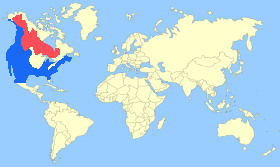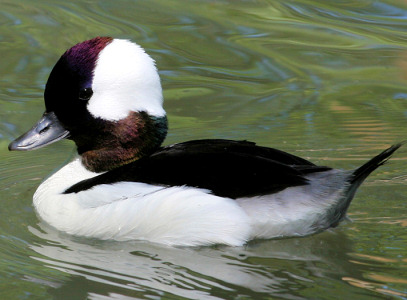Appearance:
Male - The male Bufflehead has a black head and upper neck with shades of blue, green and violet, bluish-grey beak, eyes are dark-brown, a large patch of white extend from behind the eye to the back of the head which forms a crest, upperparts are black, lower neck and underparts are white, and the legs and feet are pink.
Female - The female has a dark-brown head with a white patch behind and below the eye, blackish-brown upperparts, greyish-white underparts, dark-grey beak, dark-brown eyes, and legs and feet are greyish.
Eclipse - The male in eclipse plumage is similar to the female but has a larger white patch on its face and retains its wing pattern.
 |
 |
 |
Size: - Typical Adult is 32-40cm (12-16in).
Food: - Seeds, aquatic insects, aquatic plants, crustaceans, and molluscs.
Habitat/Range: - Wooded lakes, ponds, open inland waters, and coastal waters in Alaska and Canada. Winters further south in USA and Mexico.

 Breeding Habitat/Resident,
Breeding Habitat/Resident,  Migration or Winter Area.
Migration or Winter Area.Breeding Season: - May to June.
Eggs: - 6 to 11 (cream to pale olive colour).
Notes: - The Bufflehead is a small American sea duck. It gets its name because when the male puffs out his head feathers it resembles a Buffalo head. The Bufflehead nests in tree cavities particularly holes made by Northern Flickers (American woodpeckers).
Conservation status (IUCN 3.1):
Least Concern.
Classification: - Family: Anatidae,
Subfamily: Merginae, Genus: Bucephala.




















































